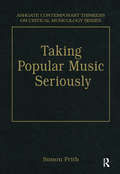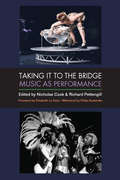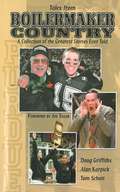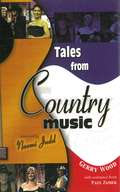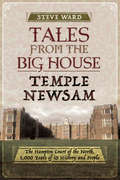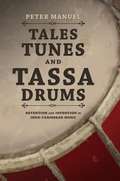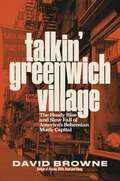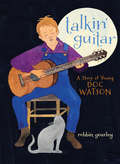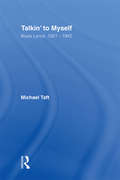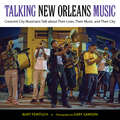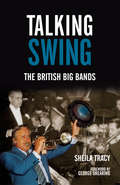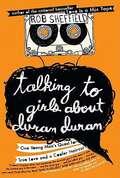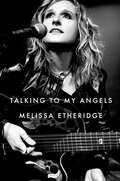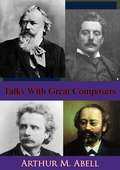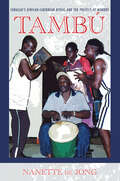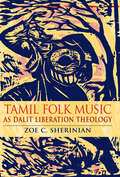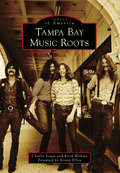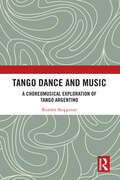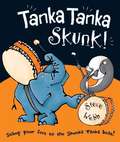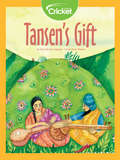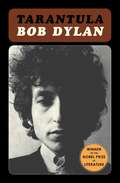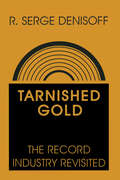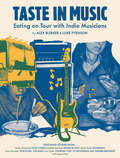- Table View
- List View
Taking Popular Music Seriously: Selected Essays (Ashgate Contemporary Thinkers On Critical Musicology Ser.)
by Simon FrithAs a sociologist Simon Frith takes the starting point that music is the result of the play of social forces, whether as an idea, an experience or an activity. The essays in this important collection address these forces, recognising that music is an effect of a continuous process of negotiation, dispute and agreement between the individual actors who make up a music world. The emphasis is always on discourse, on the way in which people talk and write about music, and the part this plays in the social construction of musical meaning and value. The collection includes nineteen essays, some of which have had a major impact on the field, along with an autobiographical introduction.
Taking it to the Bridge: Music as Performance
by Nicholas Cook Richard PettengillThe overriding aim of this groundbreaking volume--whether the subject is vocal ornamentation in 19th-century opera or the collective improvisation of the Grateful Dead--is to give new recognition to performance as the core of musical culture. The collection brings together renowned scholars from performance studies and musicology (including Philip Auslander, David Borgo, Daphne Brooks, Nicholas Cook, Maria Delgado, Susan Fast, Dana Gooley, Philip Gossett, Jason King, Elisabeth Le Guin, Aida Mbowa, Ingrid Monson, Roger Moseley, Richard Pettengill, Joseph Roach, and Margaret Savilonis), with the intent of sparking a productive new dialogue on music as performance. Taking It to the Bridge is on the one hand a series of in-depth studies of a broad range of performance artists and genres, and on the other a contribution to ongoing methodological developments within the study of music, with the goal of bridging the approaches of musicology and performance studies, to enable a close, interpretive listening that combines the best of each. At the same time, by juxtaposing musical genres that range from pop and soul to the classics, and from world music to games and web-mediated performances, Taking It to the Bridge provides an inventory of contrasted approaches to the study of performance and contributes to its developing centrality within music studies.
Tales From Boilermaker Country: A Collection of the Greatest Stories Ever Told
by Doug GriffithsThe history of Purdue athletics is sometimes funny, sometimes poignant and triumphant and often pretty amazing -- but always uniquely human. Along the way many characters have arisen in over 11 decades of competition and nearly 200 of these great stories are chronicled in Tales from the Boilermaker Country. On the hardwood, readers will learn why Purdue turned down its first opportunity to play in the NCAA Tournament, allowing archrival Indiana to win the 1940 title and how the first "Big Dog" in Purdue men's basketball history wasn't Glenn Robinson. From the football sidelines, the authors reveal the dramatic incident which almost cost the lives of Rose Bowl heroes Bob Griese and George Catavolas at the 1967 Hula Bowl. Also, readers will find out how long-time New York Yankees' owner George Steinbrenner became an assistant coach for the Purdue football team and a quarter century later was instrumental in luring the Boilermakers' NCAA Final Four coach away from ! Purdue. Included are the stories of Purdue's national championship teams; the 1961 golf team which was led by a player that never lost to golfing legend Jack Nicklaus and the triumphant story of the 1999 Purdue women's basketball team surviving three coaching changes en route to a national title. You will enjoy reading stories from some of the colorful characters in the school's past: Mike Alstott, Lin Dunn, Gene Keady, George King, Ward "Piggy" Lambert, Jack Mollenkopf, Michael "Scooby" Scearce, Moose Skowron and Joe Tiller -- to name a few. And you will travel back to the early days and the origins of Boilermaker sports when the team traveled by train and continue through the digital age when Heisman Trophy hopeful Drew Brees was promoted for the award in cyberspace.
Tales From Country Music
by Gerry WoodFollow Gerry Wood on his journey with country music's biggest stars, featuring Dolly Parton, Willie Nelson, Shania Twain and many more familiar names in the industry. Tales from Country Music will take you backstage and behind the scenes with some of your favorite country music singers.
Tales from the Big House: The Hampton Court of the North, 1,000 Years of Its History and People
by Steve WardSituated only 4 miles southeast of the bustling cosmopolitan city of Leeds lies a jewel in the crown of British stately homes. Set in 1,200 acres of rolling parkland and woods is Temple Newsam House, once described as the Hampton Court of the North.The estate has survived almost 900 years of history. Although first mentioned in the Domesday Book, it was the Knights Templar who gave the name to the land. The house that now stands on the site was begun in 1518 and has witnessed many events: the execution for treason of one of its owners; the birth of Lord Darnley, unlucky husband of Mary Queen of Scots; the Civil War rivalry of a family; the home of a flirtatious mistress of the Prince of Wales (later George IV); and the suffering of the First World War, when it was used as a convalescent home for wounded soldiers.The house and estate is now owned by the Leeds City Council and is open as a public park for all to enjoy. The house itself is part of Leeds Museums and Galleries and displays many different collections and exhibitions. On the estate is a working farm, known as Home Farm, which is the largest working rare breed center in the UK and is a popular attraction for many visitors.
Tales, Tunes, and Tassa Drums: Retention and Invention into Indo-Caribbean Music
by Peter ManuelToday's popular tassa drumming emerged from the fragments of transplanted Indian music traditions half-forgotten and creatively recombined, rearticulated, and elaborated into a dynamic musical genre. A uniquely Indo-Trinidadian form, tassa drumming invites exploration of how the distinctive nature of the Indian diaspora and its relationship to its ancestral homeland influenced Indo-Caribbean music culture. Music scholar Peter Manuel traces the roots of neotraditional music genres like tassa drumming to North India and reveals the ways these genres represent survivals, departures, or innovative elaborations of transplanted music forms. Drawing on ethnographic work and a rich archive of field recordings, he contemplates the music carried to Trinidad by Bhojpuri-speaking and other immigrants, including forms that died out in India but continued to thrive in the Caribbean. His reassessment of ideas of creolization, retention, and cultural survival defies suggestions that the diaspora experience inevitably leads to the loss of the original culture, while also providing avenues to broader applications for work being done in other ethnic contexts.
Talkin' Greenwich Village: The Heady Rise and Slow Fall of America's Bohemian Music Capital
by David BrowneThe definitive history of the rise and heyday of the revolutionary Greenwich Village music scene, based on new research and first-hand interviews with many of its legendary performers Although Greenwich Village encompasses less than a square mile in downtown New York, rarely has such a concise area nurtured so many innovative artists and genres. Over the course of decades, Billie Holiday, the Weavers, Sonny Rollins, Dave Van Ronk, Ornette Coleman, Bob Dylan, Nina Simone, Phil Ochs, and Suzanne Vega are just a few who migrated to the Village, recognizing it as a sanctuary for visionaries, non-conformists, and those looking to reinvent themselves. Working in the Village&’s smokey coffeehouses and clubs, they chronicled the tumultuous Sixties, rewrote jazz history, and took folk and rock & roll into places they hadn&’t been before. Based on over 150 new interviews (Judy Collins, Sonny Rollins, Herbie Hancock, Eric Andersen, Suzzy and Terre Roche, Suzanne Vega, Steve Forbert, Arlo Guthrie, John Sebastian, Shawn Colvin, the members of the Blues Project, and more), previously unseen documents, and author David Browne&’s longtime immersion in the scene, Talkin&’ Greenwich Village lends the saga the epic, panoramic scope it&’s long deserved. It takes readers from the Fifties jamborees in Washington Square Park and into landmark venues like Gerde&’s Folk City, the Gaslight Café, and the Village Vanguard, onto Dylan&’s momentous arrival and returns, the no-holds-barred Seventies years (West Village discos, National Lampoon&’s Lemmings), and the folk revival of the Eighties (Vega&’s enduring &“Tom&’s Diner&”). In eye-opening fashion, Browne also details the often-overlooked people of color in the Sixties folk clubs, reveals how the FBI and city government consistently kept their eyes on the community, unearths the machinations behind the infamous &“beatnik riot&” in Washington Square Park, and tells the interconnected tales of Van Ronk, the seminal band the Blues Project, and the beloved sister trio, the Roches. In also recounting the racial tensions, crackdowns, and changes in New York and music that infiltrated the neighborhood, Talkin&’ Greenwich Village is more than just vivid cultural history. It also speaks to the rise and waning of bohemian culture itself, set to some of the most enduring lyrics, melodies, and jazz improvisations in American music.
Talkin' Guitar: A Story of Young Doc Watson
by Robbin GourleyArthel "Doc" Watson (1923–2012) was a Grammy-winning guitarist, singer, and songwriter, high in the pantheon of bluegrass and country music greats. This picture book tells the story of a country boy, born blind, who found music in the sounds around him and learned to play that music on his guitar. Minimal text and breathtaking illustrations pay tribute to Doc's early determination, imagination, and musicianship. Includes additional biographical information.
Talkin' to Myself: Blues Lyrics, 1921-1942
by Michael TaftTalkin' to Myself: Blues Lyrics, 1921-1942 is a compendium of lyrics by the great blues recording artists of the classic blues era. It includes over 2000 songs, transcribed directly from the original recordings, making it by far the most comprehensive and accurate collection of blues lyrics available.
Talking New Orleans Music: Crescent City Musicians Talk about Their Lives, Their Music, and Their City (American Made Music Series)
by Burt FeintuchIn New Orleans, music screams. It honks. It blats. It wails. It purrs. It messes with time. It messes with pitch. It messes with your feet. It messes with your head. One musician leads to another; traditions overlap, intertwine, nourish each other; and everyone seems to know everyone else. From traditional jazz through rhythm and blues and rock 'n' roll to sissy bounce, in second-line parades, from the streets to clubs and festivals, the music seems unending. In Talking New Orleans Music, author Burt Feintuch has pursued a decades-long fascination with the music of this singular city. Thinking about the devastation—not only material but also cultural—caused by the levees breaking in 2005, he began a series of conversations with master New Orleans musicians, talking about their lives, the cultural contexts of their music, their experiences during and after Katrina, and their city. Photographer Gary Samson joined him, adding a compelling visual dimension to the book. Here you will find intimate and revealing interviews with eleven of the city's most celebrated musicians and culture-bearers—Soul Queen Irma Thomas, Walter “Wolfman” Washington, Charmaine Neville, John Boutté, Dr. Michael White, Deacon John Moore, Cajun bandleader Bruce Daigrepont, Zion Harmonizer Brazella Briscoe, producer Scott Billington, as well as Christie Jourdain and Janine Waters of the Original Pinettes, New Orleans's only all-woman brass band. Feintuch's interviews and Samson's sixty-five color photographs create a powerful portrait of an American place like no other and its worlds of music.
Talking Swing: The British Big Bands
by Sheila TracyFrom Palace to Palais, the musicians who played in the big bands tell their own stories, bringing to life an unforgettable era.Pre-war reminiscences give an insight into a never-to-be-forgotten era, when London's nightclubs were the haunts of the aristocracy and of royalty, and the Prince of Wales would jump at any opportunity to play drums with the resident band. The elegant world of top hat, white ties and tails has gone for ever, but in Talking Swing the musicians relive those nights when they played for as long as the customers wanted to dance - often into the early hours of the morning. Out of London, there were the variety tours, where the band was top of the bill and there wasn't an empty seat in the house.The problems faced by British musicians during the war years, when London's society bands continued to play throughout the Blitz, were enormous, and they are vividly portrayed in Talking Swing.Amongst those recalled are Ambrose, Jack Hylton, Geraldo, Ted Heath and Syd Lawrence, who took over when almost everyone else had packed it in and who kept on swinging against all odds. This was the golden age of the big bands, and the story of those days is told by the men and women who made the music.
Talking to Girls About Duran Duran
by Rob SheffieldFrom the bestselling author of Love Is a Mix Tape and Turn Around Bright Eyes, "a funny, insightful look at the sublime torture of adolescence". -Entertainment Weekly The 1980s meant MTV and John Hughes movies, big dreams and bigger shoulder pads, and millions of teen girls who nursed crushes on the members of Duran Duran. As a solitary teenager stranded in the suburbs, Rob Sheffield had a lot to learn about women, love, music, and himself. And he was sure his radio had all the answers. As evidenced by the bestselling sales of Sheffield's first book, Love Is a Mix Tape, the connection between music and memory strikes a chord with readers. Talking to Girls About Duran Duran strikes that chord all over again, and is a pitch-perfect trip through '80s music-from Bowie to Bobby Brown, from hair metal to hip-hop. But this book is not just about music. It's about growing up and how every song is a snapshot of a moment that you'll remember the rest of your life. .
Talking to My Angels
by Melissa EtheridgeTwenty years after the success of her first memoir, the New York Times bestseller The Truth Is . . ., the Grammy and Oscar award-winning rocker and trailblazing LGBTQAI icon takes stock of the intervening years, recounting the euphoric triumphs and the life-altering tragedies of her life. <p><p> The audiobook is an exclusive musical experience, read and performed by Melissa. It features live, stripped-down performances of many of Melissa’s songs, including the one that inspired the book title, Talking to My Angel; never-before performed songs including Here Comes the Pain; and original interstitial and credit music. <p><p> Live with spirit. <p> Find peace in the chaos. <p> Lean into the joy. <p><p> Over the past twenty years, Melissa Etheridge has been blessed with success, love, joy, contentment, freedom, and release. She became a mother again, recorded eleven albums, toured the world, performed at the Grammy Awards, won an Oscar, discovered her one true love, and underwent a profound spiritual awakening. She also experienced illness, incomparable loss, heartache, guilt, shame, and devastating grief. She was diagnosed with breast cancer, endured two contentious and public break ups, and witnessed the devastating disintegration and death of her son, Beckett, to opioid addiction. Yet through it all, Melissa found the strength and courage to carry on. <p><p> Talking to My Angels is a profoundly honest look into her inner life as a woman, an artist, a mother, and a survivor. With characteristic wit and courage, Melissa delves into how numerous tragedies served as a catalyst for growth, and what the past two decades have taught her about the value of music, love, family, and life in the face of death. It is her story: as raw, vulnerable, and electrifying as her acclaimed songs. Melissa shares hard truths about surviving and thriving—a journey through darkness and uncertainty that leads to forgiveness and love. A remarkable storyteller, she digs deep into the well of her life, sharing memories that, woven together, create a rich portrait of success and survival—an intimate, emotional and ultimately inspiring story of healing. <p><p> A memoir a lifetime in the making, Talking to My Angels is Melissa’s engrossing—and at times harrowing—story as she lived it. It is a testament to the power of art, a touchstone for anyone seeking a path out of darkness, and a powerful love letter to the family and fans who’ve been integral to her journey. <p> <b>New York Times Bestseller</b>
Talks With Great Composers: Candid Conversations With Brahms, Puccini, Strauss, And Others (Wisdom Library Ser.)
by Arthur M. AbellWho does not ponder what inspires creativity? Why does one person excel as a doctor, another as an artist, and yet a third as a composer? Why do some fortunate people seem overly endowed with an abundance of creativity--this most precious of gifts--and others with little or none at all? Can creative inspiration be nurtured slowly and, suddenly, spring forth to mesmerize and enchant the world?In the words of Emanuel Ax, we are given "fascinating glimpses into the innermost thoughts of some of our greatest composers" in this series of intimate and deeply felt conversations between Arthur Abell and Brahms, Puccini, Strauss, Humperdinck, Bruch, and Grieg. And through these revelations, one can understand with greater clarity the essence of genius.In its entirety, the book is a paean to both the musical world and to those few who achieved greatness during the latter part of the 19th century and the early years of the 20th century. We cannot fail to be deeply impressed by the intense outpouring of emotion demanded by great creative endeavor. And here, nothing is spared. We are privy to the highs and lows--the great triumphs and the wrenching failures.Talks with Great Composers brings to life the thoughts, fears, self-doubt, inherent religiosity, and the unparalleled joys that, by the end of the book, we come to appreciate must accompany all of life's greatest challenges and accomplishments.
Tallinn '67 Jazz Festival: Myths and Memories
by Heli ReimannTallinn ’67 Jazz Festival: Myths and Memories explores the legendary 1967 jazz gathering that centered Tallinn, Estonia as the jazz capital of the USSR and marked both the pinnacle of a Soviet jazz awakening as well as the end of a long series of evolutionary jazz festivals in Estonia. This study offers new insights into what was the largest Soviet jazz festival of its time through an abundance of collected materials – including thousands of pages of archival documents, more than a hundred hours of interviews and countless media reviews and photographs – while grappling with the constellation of myths integral to jazz discourse in an attempt to illuminate ‘how it really was’. Accounts from musicians, jazz fans, organisers and listeners bring renewed life to this transcultural event from more than half a century ago, framed by scholarly discussions contextualizing the festival within the closed conditions of the Cold War. Tallinn ’67 Jazz Festival details the lasting international importance of this confluence of Estonian, Soviet and American jazz and the ripple effects it spread throughout the world.
Tambú: Curaçao's African-Caribbean Ritual and the Politics of Memory (Ethnomusicology Multimedia)
by Nanette de JongAs contemporary Tambú music and dance evolved on the Caribbean island of Curaçao, it intertwined sacred and secular, private and public cultural practices, and many traditions from Africa and the New World. As she explores the formal contours of Tambú, Nanette de Jong discovers its variegated history and uncovers its multiple and even contradictory origins. De Jong recounts the personal stories and experiences of Afro-Curaçaoans as they perform Tambu–some who complain of its violence and low-class attraction and others who champion Tambú as a powerful tool of collective memory as well as a way to imagine the future.
Tamil Folk Music as Dalit Liberation Theology
by Zoe C. SherinianZoe C. Sherinian shows how Christian Dalits (once known as untouchables or outcastes) in southern India have employed music to protest social oppression and as a vehicle of liberation. Her focus is on the life and theology of a charismatic composer and leader, Reverend J. Theophilus Appavoo, who drew on Tamil folk music to create a distinctive form of indigenized Christian music. Appavoo composed songs and liturgy infused with messages linking Christian theology with critiques of social inequality. Sherinian traces the history of Christian music in India and introduces us to a community of Tamil Dalit Christian villagers, seminary students, activists, and theologians who have been inspired by Appavoo's music to work for social justice. Multimedia components available online include video and audio recordings of musical performances, religious services, and community rituals.
Tampa Bay Music Roots (Images of America)
by Charlie Souza Keith WilkinsWhen the Peerless Quartet wrote "Way Down On Tampa Bay" in 1914, Tampa Bay's musical roots started growing. Tampa Bay is where Ray Charles created his first song, Hank Ballard wrote and recorded "The Twist," and the Rolling Stones cranked out their hit "Satisfaction." Stephen Stills attended both Plant High School and Admiral Farragut Academy, and Jim Morrison studied at St. Petersburg Junior College. Ella Fitzgerald kicked off her career on the storied Central Avenue in Ybor City. Savatage, Stranger, Diamond Grey, the Outlaws, Bleeding Hearts, Blackkout, the Arena Twins, Tampa Red, and Cheeky Monkey are all artists who have made a huge impact both locally and nationally. From its rock 'n' roll boom in the 1960s to the birth of death metal in the 1980s . . . Tampa Bay has had a rich musical history!
Tango Dance and Music: A Choreomusical Exploration of Tango Argentino
by Kendra StepputatThis book investigates choreomusical aspects of tango argentino in translocal practice, in particular its current manifestation in Europe. It looks at translocal tango argentino in its many facets: movement structures, sound structures, dancers and musicians, and the complex relations between these factors that all have their share in shaping the practice. Beyond being the first extensive monograph about translocal tango music and dance, the book crosses borders in the use of both qualitative and quantitative methods, ranging from participant observation to statistical data evaluation, including optical motion capture for movement analysis. The book contains a brief historical overview of tango argentino practice in the twentieth century, bringing together the development of music and dance in a holistic way to better understand the background of the current interconnectedness. The first main part of the book focuses on the “danceability” aspect of tango music. The exploration is based on tango DJs’, tango dance teachers’, and tango musicians’ view of tango danceability as well as experimental approaches. The second part is dedicated to tango dance and its “musicality”. It investigates with quantitative and qualitative methods tango movement repertoire and principles and how these relate to tango musical features.
Tania León's Stride: A Polyrhythmic Life (Music in American Life)
by Alejandro L. MadridAcclaimed composer, sought-after conductor, esteemed educator, tireless advocate for the arts--Tania León’s achievements encompass but also stretch far beyond contemporary classical music. Alejandro L. Madrid draws on oral history, archival work, and ethnography to offer the first in-depth biography of the artist. Breaking from a chronological account, Madrid looks at León through the issues that have informed and defined moments in her life and her professional works. León’s words become a starting ground--but also a counterpoint--to the accounts of the people in her orbit. What emerges is more than an extraordinary portrait of an artist's journey. It is a story of how a human being reacts to the challenges thrown at her by history itself, be it the Cuban revolution or the struggle for civil and individual rights. Nuanced and multifaceted, Tania León's Stride looks at the life, legacy, and milieu that created and sustained one of the most important figures in American classical music.
Tanka Tanka Skunk
by Steve WebbRhyming has never been so much fun as in Steve Webb's bold, new picture book, which encourages children to read aloud, following the easy and catchy rhythm of the text. "Skunka Tanka Skunka Tanka Tanka Tanka Skunk! They've got the beat, and so do their friends." "Meet Tanka and his friend, Skunk. When you say their names together, they sound like drums!" Steve Webb's innovative and visually stunning picture book introduces young readers to simple rhythms with this riot of shout-out-loud words and cavorting animals. TANKA TANKA SKUNK! makes reading tons of fun as the text and the illustrations leap and dance across the pages.
Tansen's Gift
by Dawn Renée LevesqueIn India, stories spread about the magical powers in the songs of a young boy named Tansen. Years later while hunting in the forest, Emperor Akbar witnesses the magic of Tansen’s voice. Now a member of Akbar’s court, Tansen is challenged by the other musicians to perform the Deepak Raga, a song that could bring fire and death to the singer. Will Tansen be able to survive the dangers of this song?
Tarantula
by Bob DylanMusic legend Bob Dylan's only work of fiction—a combination of stream of consciousness prose, lyrics, and poetry that gives fans insight into one of the most influential singer-songwriters of our time.<P><P> Written in 1966, Tarantula is a collection of poems and prose that evokes the turbulence of the times in which it was written, and gives a unique insight into Dylan's creative evolution. It captures Bob Dylan's preoccupations at a crucial juncture in his artistic development, showcasing the imagination of a folk poet laureate who was able to combine the humanity and compassion of his country roots with the playful surrealism of modern art. Angry, funny, and strange, the poems and prose in this collection reflect the concerns found in Dylan's most seminal music: a sense of protest, a verbal playfulness and spontaneity, and a belief in the artistic legitimacy of chronicling everyday life and eccentricity on the street.<P> Winner of the Nobel Prize for Literature
Tarnished Gold: Record Industry Revisited
by R. Serge DenisoffThe great depression in the popular recording industry that began in 1979 still continues. There are signs, however, that the industry is adjusting to new technologies and may soon revive. R. Serge Denisoff documents the decline and possible revival of this comprehensive study of the recording business, a sequel to his widely acclaimed Solid Gold: The Popular Record Industry. Denisoff offers a brief history of popular music and then, in detail, traces the life cycle of a record, beginning with the artist in the studio and following the record until its purchase. He explains the relationships between artist, manager, producer, company, distributor, merchandiser, and media. They all play roles in the scenario of a hit record. He also discusses the new technologies and how they may affect record sales, especially round-the-clock rock and roll on cable television. Tarnished Gold joins Solid Gold as a staple in the popular culture literature.
Taste in Music: Eating on Tour with Indie Musicians
by Luke Pyenson Alex BleekerA Pitchfork Best Book of 2024A Saveur Best Narrative Food Book of 2024In this unique and deeply thoughtful collection, musician Alex Bleeker (Real Estate) and food and travel journalist Luke Pyenson (formerly of Frankie Cosmos) take readers on tour with a diverse lineup of inspiring indie musicians from around the world, sharing meals and travel experiences, peeking behind the curtain at this singular and singularly misunderstood way of life.Through original essays and engaging conversations with dozens of indie musicians representing several subgenres, scenes, and eras, food takes center stage in stories about being on tour and eating on tour and how this basic human necessity can create a sense of community and interconnectedness in one of the most mobile industries in the world. Based broadly on the subject of eating on tour, these entries each spin off into their own focused and exciting behind-the-scenes story, but all confirm what Pyenson and Bleeker suspected all along—food looms large in the lives of touring musicians, and it can be used as a gateway into understanding what going on tour is really like.Featured contributors include:Robin Pecknold (Fleet Foxes) Chris Frantz (Talking Heads) Natalie Mering (Weyes Blood) Mark Ibold (Pavement)John Gourley (Portugal. The Man)Lily Chait (touring chef to boygenius and Phoebe Bridgers) Amelia Meath (Sylvan Esso)Greta Kline (Frankie Cosmos) Devendra BanhartBob Mould (Hüsker Dü) Brian "Geologist" Weitz (Animal Collective)Dawn RichardSasami Ashworth (SASAMI)Sadie Dupuis (Speedy Ortiz)The BethsIn addition to wide-angle meditations about eating on tour, Pyenson and Bleeker have gathered stories that take place on five continents, in private homes and street-side stalls, in temples of fine dining and in actual temples, backstage and in the van, early morning and late at night. Stories that deal with the best parts of touring: meaningful cultural exchange, hospitality-induced euphoria, and the opportunity to build relationships around the world. And the worst: loneliness, exhaustion, estrangement from family and friends, struggles with disordered eating, and unsteady access to medical care.So the question isn’t, “How was tour?” It’s, “What do you eat on tour?” Like the best songs or meals, these conversations and essays evoke something central about the human experience. They show us all the ways that music and food bring us together, break us down, lift us up, and add color to our lives.NOTABLE AUTHORS: With over twenty years of experience in the music industry, Alex Bleeker and Luke Pyenson are your perfect guides into the world of touring. Having toured with their own bands—Real Estate and Frankie Cosmos, respectively—they're asking all the right questions, shedding light and understanding on the lives of touring musicians and the people feeding them.FOOD ANTHOLOGY & MUSIC SCENE DEEP CUT: With interviews and essays from about forty different musicians, chefs, and promoters—ranging from Chris Frantz from Talking Heads to boygenius’s private chef Lily Chait—not only is this book a treasure trove of knowledge and insider information, it also offers something for foodies and music enthusiasts alike.ARMCHAIR TRAVEL: Go behind the curtain all around the world, from America to Russia, Japan to Italy, and dozens of places in between. Read about your favorite musicians’ experiences abroad, all from the comfort of your home. Perfect for:Musicians and fans of indie musicFoodies, chefs, restaurant owners, and home cooksAnyone interested in the music businessTravel enthusiasts Readers who enjoyed <em
